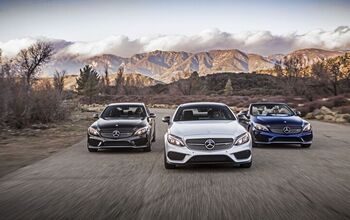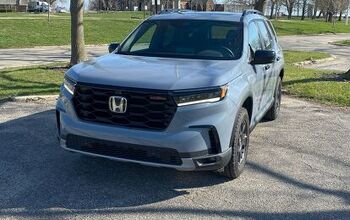Why Aren't Americans Buying Mazdas?
Through the first-quarter of 2016, U.S. auto sales volume grew 3 percent compared with the same period in record-setting 2015.
Mazda’s U.S. sales have fallen 17 percent, a meaningful decline of 13,399 sales over the course of only three months.
Something isn’t clicking for Mazda.
Mazda’s shrinking passenger car lineup is down 23 percent, a loss largely incurred by the declining Mazda3 and Mazda6. Mazda’s “light-truck” division, however, is suffering from the near disappearance of the Mazda5 minivan, a CX-9 replacement phase, and a minor slide in sales of Mazda’s best seller, the CX-5.
Three months in, there’s plenty of time for Mazda to turn 2016 around and improve upon 2015, when Mazda USA sales climbed to a 21-year high. Yet even during that banner year, Mazda was hardly a consequential automaker in the United States, earning just 1.8% market share. That’s measurably less than Mercedes-Benz, Lexus, and BMW. Mazda Canada’s market share is more than double what Mazda USA achieves, yet Mazda is losing Canadian market share every year.
Something is clearly not clicking.
Car reviewers gleefully toss a Mazda3 through a series of bends, enamoured by its interactivity, only to discover that real consumers prefer eight other compact cars. Industry insiders look at the flowing lines of a Mazda6 and are left to wonder at the 10 other midsize cars that sell more often. Mazda is soaring up Consumer Reports’ ratings, too, and all Mazdas receive CR recommendations.
Mazda’s characteristically superior on-road behaviour obviously means little to the typical consumer, regardless of the insistent auto writers who would rather see consumers rowing their own in a Mazda3 than enduring a CVT-equipped Corolla.
Why aren’t they buying more Mazdas? We have a few good guesses, so I’m answering that question for every Mazda by taking the place of a consumer, not the car reviewer. Let’s be clear: I could do this for almost every automaker. Mazda’s case is pertinent now because of Mazda’s currently weak sales.
What would stop me from buying a Mazda? Here’s one chief reason for each Mazda vehicle, leaving the CX-9 be until we’ve had more exposure.
MAZDA CX-3
The CX-3’s snug rear seat and tiny cargo compartment wouldn’t deter me if I was seeking an all-wheel-drive subcompact crossover. And while 146-horsepower sounds like very little, the CX-3 is sufficiently powerful in daily driving.
But the CX-3 is way too low.
If you’re going to indirectly replace a subcompact car with a subcompact crossover, isn’t a key part of the switchover ride height? Sitting in a CX-3, I feel like I’m perfectly positioned to study a pickup truck’s nether regions. There are only six inches of ground clearance, and no amount of black cladding can make up for that. Of course it handles well for an SUV — it’s as low as a freaking car. At least the Jeep Renegade, which is just as chock full of faults as every subcompact utility, has an aura of SUV authenticity because of its loftier perch.
MAZDA3
On my strong recommendation, my best friend leased a new Mazda3 hatchback at the end of March, flying in the face of a trend that has seen U.S. and Canadian sales fall 21 percent so far this year. But even he couldn’t accept his base model Mazda3 as is. Kenny removed the Mazda3’s covered 16-inch wheels (to use as winters) and replaced them with the 17-inch alloys off his dead first-gen Mazda6. It looks amazing. But 17-inchers on a new Mazda3?
17s on a 3 are odd, indeed. But to escape the empty wheelarch/tippy-toe look of most Mazda3s, Mazda required Kenny to spend an extra $7,000 CAD to get 18-inch rims (and plenty of other stuff). Forget any 17-inch mid-way option.
Should crippling, undersized wheels have been a deal-breaker for Kenny? (They almost were until he remembered he still technically owned the Mazda6.) Perhaps not, but his experience speaks to the way Mazda allows even mid-grade versions of the very handsome Mazda3 to look very cheap. Midst discussion of Mazda’s premium-ness in early 2013, Mazda’s CEO said that he needed consumers to, “ appreciate the value of the product.” Mazda might find more appreciation when they get rid of 16-inch wheel covers on a $20,415 USD Mazda3 i Sport 5-Door.
MAZDA 6
I love a good-looking midsize sedan as much as the next minivan owner. If that handsome exterior is paired with a willing chassis, consider me excited. But I don’t grasp the point of stepping up from a fun and comfortable car like the Mazda3 if the Mazda6 isn’t going to be more comfortable for more people.
The Mazda6’s swoopy roofline eats into rear headroom. The center hump would make five-aboard trips a pain. These aren’t problems in an almost-flat-floor, not exactly swoopy roofed Toyota Camry.
MAZDA CX-5
A criticism levelled against most Mazdas relates to noise, vibration, and harshness. But up against refined, perennial best-selling Honda CR-V, the CX-5’s wind noise and engine clatter are irritating. Its tire hum is, say it with me, tiresome.
The CX-5 is surrounded by rivals which don’t steer, handle, shift, or brake with any joy, but the Mazda CX-5’s dynamic appeal will be lost on many buyers who just want a quiet family hauler.
MAZDA MX-5 MIATA
If I had the money and driveway space for an ND MX-5, I believe I’d pull the trigger in an instant.
Or would I? The last time I spent a week with a Miata, my friends all made fun of me. Kenny even called me Grandpa.
I’m my own man, of course, and I back that up in vehicular terms by being happy with minivan ownership. But minivan ownership makes me look precisely my age; minivan ownership suggests absolutely truthful notions to those who see me driving a Honda Odyssey.
MX-5 ownership, however, is another matter. Aside from seemingly every second young auto writer in North America, MX-5s seem to be driven only by the most hoary-headed among us. Perhaps that’s just my locale, but then again, that is where I would be driving my MX-5.
“Not wanting to look like I’m 72,” seems like a justifiable reason to avoid dressing a certain way, a fair argument for not dining out at a certain time, and proper logic for playing tennis instead of pickleball. But I hope I don’t give in to such logic if I save the money and buy the garage.
I may sneer at small-wheeled Mazda3s, literally look down upon CX-3 drivers, never see any humans in the rear seat of a Mazda6, and wonder if every CX-5 I drive is wearing winter tires. But I really want a Miata.
[Images: Mazda]
Timothy Cain is the founder of GoodCarBadCar.net, which obsesses over the free and frequent publication of U.S. and Canadian auto sales figures. Follow on Twitter @goodcarbadcar and on Facebook.
More by Timothy Cain
Latest Car Reviews
Read moreLatest Product Reviews
Read moreRecent Comments
- 1995 SC Didn't Chrysler actually offer something with a rearward facing seat and a desk with a typewriter back in the 60s?
- The Oracle Happy Trails Tadge
- Kwik_Shift_Pro4X Union fees and corruption. What can go wrong?
- Lou_BC How about one of those 2 foot wide horizontal speedometers out of the late 60's Ford Galaxie?
- Lou_BC Was he at GM for 47 years or an engineer for 47 years?






































Comments
Join the conversation
I wonder how many of these comments are the paid Hyundai/Kia trolls that are known on YouTube. Spreading lies and exaggerations. Cant believe a car manuf would stoop so low as the Koreans have been doing. SMH!...
They have two really, really simple problems. Mazda can easily thrive in their niche as long as they own it completely and don't bleed away sales by leaving customers dissatisfied and broke. 1) They rust. Mazda needs to offer a 15-year anticorrosion warranty; that will force them to move on from the 1980s anticorrosion strategies. Enthusiasts like to keep their cars a long time and take care of them. Nothing ruins the experience of keeping an old car around than having to get out the hacksaw and the die grinder. 2) They do not have a reliable powertrain over 184 horsepower. The Renesis rotaries wore out before 125,000 miles. The DISI-Turbo 2.3 bent rods, stretched timing chains, and blew turbochargers, all at random intervals from brand new to 200,000 miles; meanwhile the AWD system bolted to them broke both itself and the gearbox and clutch that it overloaded. If the new turbo 2.5 is to prove out any better, they need to give owners an incentive to keep the cars stock and maintain them. It should have a 10/150 powertrain warranty. If the cars are seen as high quality, they can split the difference between the Toyota/Honda price bracket and the BMW/Merc price bracket.